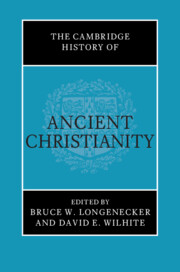Book contents
- The Cambridge History of Ancient Christianity
- The Cambridge History of Ancient Christianity
- Copyright page
- Contents
- Figures
- List of Contributors
- Editors’ Preface
- Part I Contested Contexts
- Part II Contested Figures
- Part III Contested Heritage
- Part IV Contested Cultures
- Part V Contested Beliefs
- Part VI Contested Bodies
- 24 Masculinity, Femininity, and Sexuality
- 25 Christian Slavery in Theology and Practice
- 26 Wealth, Almsgiving, and Poverty
- 27 Power, Authority, the Living, and the Dead
- Ancient Sources
- Modern Authors
- References
24 - Masculinity, Femininity, and Sexuality
The Construct of Self-Control in Early Christianity
from Part VI - Contested Bodies
Published online by Cambridge University Press: 23 August 2023
- The Cambridge History of Ancient Christianity
- The Cambridge History of Ancient Christianity
- Copyright page
- Contents
- Figures
- List of Contributors
- Editors’ Preface
- Part I Contested Contexts
- Part II Contested Figures
- Part III Contested Heritage
- Part IV Contested Cultures
- Part V Contested Beliefs
- Part VI Contested Bodies
- 24 Masculinity, Femininity, and Sexuality
- 25 Christian Slavery in Theology and Practice
- 26 Wealth, Almsgiving, and Poverty
- 27 Power, Authority, the Living, and the Dead
- Ancient Sources
- Modern Authors
- References
Summary
A central premise of this chapter is that masculinity, femininity, and sexuality are socially constructed. Across history, cultures have arrived at many different understandings of what it means to be a man or a woman, and many ways to order and direct sexual desire. Instead of assuming that attributes of masculinity or femininity are enduring, then, the historian should articulate how the ancients thought about these topics, even when their approaches differed from our own.
- Type
- Chapter
- Information
- The Cambridge History of Ancient Christianity , pp. 561 - 585Publisher: Cambridge University PressPrint publication year: 2023



